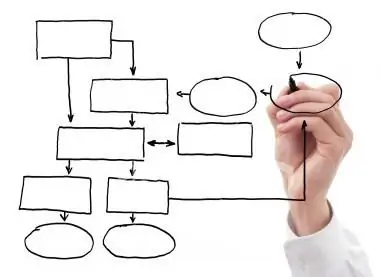2025 Author: Howard Calhoun | [email protected]. Last modified: 2025-01-24 13:10:26
Organizational processes are the process of doing work according to the plan, which is divided into three stages. Division of work, grouping into separate blocks (departments, sectors) and coordination of separate groups.
Three process examples
The following examples of process distribution can be distinguished:
- Division of work into separate stages. In this case, different types of work are assigned to an individual employee in accordance with his qualifications, skills and experience.
- Group work into separate blocks. Separate blocks mean a sector, department or subdivision in which a group of employees of the same qualification works on a specific project. With this division, work is done faster.
- Coordination of work is about resolving conflicts and building a mechanism to avoid them.

Process steps
The organizational process can be divided into several stages:
- Division of work.
- Grouping tasks.
- Coordination of work.
But there are many more that can be identified. It depends on the organization and itsactivities.
Division of work

The first step in the organizational process, with the distribution of work among employees in accordance with their qualifications and skills. At the same time, management must ensure that an individual employee does not do more or less work than his colleagues. The principle of distribution is based on the ability to distribute the working time of employees. And also that they only do the work they know how to do best.
This will reduce the time from the transition between operations, reduce training (since workers only do what they already know). Equipment and tools are also improved. There is a danger of this specialization - the monotony of labor. It deprives the employee of creative skills and their manifestation during work. To avoid this, managers most often use two methods
- Expansion of the worker's field of activity.
- Enrichment of labor.
The expansion of the field of activity is the provision of an opportunity for an employee to combine and do several jobs at once of his choice. It can also expand the tasks that are performed. The enrichment of labor is the provision of independent control over the progress of work to the employee.
Proper grouping of tasks for further execution
The stage of the company's organizational processes implies the creation of various blocks (divisions and sectors) that are responsible for individual tasks. This achieves maximum efficiency and speed of the solution.one problem or another. As a rule, those who do the same work are united in one department.
This is how work is distributed in small organizations.

Such organizations divide production departments according to their functional characteristics. That is, according to the type of work performed. Each Vice President of a separate department is responsible for certain activities of the company - sales and marketing, transportation activities and financial operations. Also, some segments can be divided into 2-3 more departments.
This diagram shows divisions in large organizations.

Vice-president levels are formed by the type of production of the enterprise. The lower level is formed by geopolitical location. The last level is organized according to the type of activity of one of the directions. These are the main types of organizational processes. Simplified, it looks like in the diagram.

Control of work
Coordination of the work of organizations allows you to control and direct employees in the right direction at the previous stages. This is done to ensure that the work is done correctly, on time and according to the plan. Coordination can be done through a chain of command. There is also another type - vertical. Here, control is divided into separate links, towering over each other.
For example, a manager controls ordinary employees. And his work is supervised by higher management. The more quantityemployees, the fewer managers are needed, because of this, information reaches management faster. But with fewer employees, the president will have to deal with more workplace conflicts.
There is another method of coordination - market, the most efficient and strong. The market is a prime example of mutual assistance in vertical coordination. It does not require a higher centralized leadership, the market is the most powerful for the producer and consumer. For some companies, the market is the most profitable method of coordination.
How is this type of work different from others?
Organizational development is a type of activity that should streamline the processes of production and management at enterprises. His concept appeared on the foundations of psychology and sociology, which were supposed to solve the resulting conflicts in practice. This term was introduced by Robert Blake in 1946-1949. at ESSO Corporation (currently Exxon).

The main difference between this process and other types of work with employees is that the organization is considered as a whole, with all interacting elements. The systematic approach consists in the sequence of consideration of functional, structural, technical and personal relationships within the organization. Also programs of this type of work consist in the analysis of the functioning and the problems associated with it.
The purpose of such solutions is to increase production efficiency. The concept of organizational development was created in order for the enterprise toactively and steadily developed. Therefore, in its name there is the word "Development". And growth will occur not at the expense of "shocks" or "impulses", but at the expense of internal resources. What is the first thing organizational development professionals try to achieve?
First of all, the balance between the resources expended and the products sold, as well as the payback of these very goods. As well as the development of the enterprise, its growth and the cohesion of the team within the organization. The results of the work of these specialists are as follows:
- preparedness of the team or staff for local or global changes;
- positive attitude of employees to each other, as well as the development of mutual assistance between them;
- optimization of the organizational and functional structures of the enterprise;
- achieving overall job satisfaction across the enterprise.
The work of such a specialist is very complex and, as mentioned above, is based on psychology and sociology. Also, after the work of these people, managers see improved product quality, higher productivity, strengthening the organization's position in the market, reducing staff loss, increasing income, etc.
The main stages that organizational growth specialists go through

Organizational growth is a continuous process divided into several stages.
- At the first stage, the specialist and management realize that it is necessary to change the enterprise in various structures. This realization can come in thosemoments when employees notice complications in the work of the enterprise. It is also important that everyone wants to change the company.
- At the second stage, after awareness and the emergence of a desire to solve problems and change the enterprise for the better, the specialist begins work. Some problems are being solved, namely, a system of working relationships is being created in order to carry out organizational changes.
- At the third stage, after the specialist can infiltrate the enterprise, he begins to collect information about him. This is a very important activity and is performed strictly according to the special technique of a specialist. Even if a firm has a we alth of information, it may not always be able to pinpoint clear organizational problems.
- At the fourth stage, after collecting enough information, it will need to be analyzed and studied. This stage can also be called diagnostic. The specialist must make the "diagnosis" and begin the "treatment", as well as implement organizational changes.
- At the fifth stage, the specialist will understand all the problems, he needs to develop a plan for their elimination and further avoidance. In this regard, he uses his special techniques. Once a plan has been drawn up, it must be executed. The specialist should oversee the implementation of the plan.
- The sixth stage, it is the final one. After the organization has changed for the better, the need for a specialist disappears. Sometimes there are cases when a company's dependence on a specialist becomes too great, it cannot function without him. These problems are alsosolved by a specialist.
The Importance of Organizational Growth
In a developing company or in one that is on the verge of bankruptcy, you need to familiarize yourself with this concept. And it is desirable to hire a specialist. His work will cost money, but the changes he will make to the enterprise will be priceless.
Recommended:
Personnel planning in the organization: stages, tasks, goals, analysis

Personnel planning is carried out in any organization and in the public service. This activity is carried out exclusively by a professional service. But still, personnel planning in the organization is carried out only in close connection with the representative of the employer or directly with the head himself
Organizational structures of an enterprise - an example. Characteristics of the organizational structure of the enterprise

The implementation of plans and programs is achieved by building an organizational structure that allows you to effectively organize the joint activities of staff through the appropriate distribution of duties, rights and responsibilities. The article highlights the elements of the organizational structure, gives examples of its various types, highlights their advantages and disadvantages
Smoking shop: preparation of necessary documents, drawing up a business plan, selection of necessary equipment, goals and stages of development

The article deals with such a business as a smoke shop. Learn how to start a business and where to start. About how to choose equipment and how it should be. About what you need to pay attention to when choosing suppliers, and about the process of producing smoked products
Advertising agency: how to open, where to start, preparation of necessary documents, drawing up a business plan, goals, objectives and stages of development

Demand for advertising services is strong throughout the year, regardless of the fact that the market is represented by a huge number of companies offering such services. Therefore, when planning how to open an advertising agency, special attention should be paid to market analysis. This will allow you to assess the real prospects of the niche, as well as create an effective business model with high profitability
What is the project structure? Organizational structure of the project. Organizational structures of project management

The project structure is an important tool that allows you to divide the entire course of work into separate elements, which will greatly simplify it

